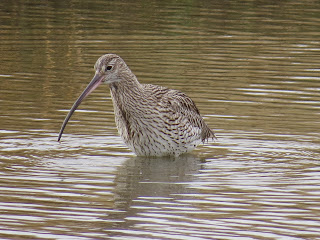 |
| Comma |
It was very warm this morning at Minsmere. It felt as if it was May than February. It was so warm, I actually had to take my coat off! Spring seems to have arrived early this year. The catkins are out and the bees were pollinating them. I even saw my first butterfly of 2017, a comma that was busy warming itself in the warm February sunshine. As if left on standby, these insects emerge into action from their winter hiding places as soon as temperatures rise a bit more than usual.
 |
| Honey Bee pollinating a Gorse flower |
 |
| Hazel catkins |
 |
| Mute Swans |
On the sightings board today, there were a couple of duck species written up there that are always worth looking for even though they are not exactly rare or anything. There were apparently some smew somewhere around the scrapes between the Wildlife Lookout hide and the pond. We went to the Wildlife Lookout first, but apart from curlews, snipe, wigeon, teal, a pair of mute swans and a kestrel, there was no sign of any smew from here.
 |
| Marsh Tit |
Next up was a walk through the woods towards Island Mere Hide. The birds seemed to be preparing for spring as many were in full song, a secret language that is used in both claiming territory and attracting a mate. Many, though, were still traveling together in noisy mixed winter flocks as they search every branch in the canopy for a morsel to eat. We watched foraging goldcrests being joined by a growing flock of many species including marsh tits, long-tailed tits, blue tits, great tits, chaffinches and siskins. Treecreepers trilled their short squeaky songs from the trunks of trees, while a green woodpecker chuckled it's yaffling call from somewhere nearby. Minsmere's marsh harriers were also in full voice as they appeared to be already sky dancing, displaying high above us. I also saw this muntjac deer grazing, not taking any notice of us standing a several feet away.
 |
| Goldcrest |
 |
| Pheasant |
 |
| Muntjac Deer |
 |
| Gulls from Bittern Hide |
 |
| Goosander |
From Island Mere Hide, the sun was shining right in our face and the surface of the mere was reflected to a blinding shimmer making in it harder to see for the most part. It was easier to see the snipe that were in the stubbled reedy pools right in front of the hide than the goosanders that I was hoping to see out on the water. The goosanders were hiding in the far corner of the mere, tucked out of sight behind a reed bed. Eventually, they did emerge into view and were moving closer and closer to the centre of this body of water, though because of the brightness of the sun, they were rather silhouetted. One of these saw-billed ducks did swim close to the shore in front of the hide, however, even from here the sun made it hard to see it clear enough. High in the sky, away from the blinding sun, I was able to spot a peregrine falcon soaring so high that it almost appeared as a dot in the clouds.
 |
| Snipe |
 |
| Marsh Harrier |
 |
| Male and female Smew |
After lunch, I heard that the smew were at a pool close to the pond near the visitor centre. A temporary viewpoint on an embankment provided Mum and I with some great views of a pair of these charming little ducks. The male stands out with its bright white plumage with black markings. A truly handsome looking bird. The female was not quite as handsome, but is best described as a redhead. Smew are winter visitors to the UK and Minsmere is a bit of a hotspot for them at this time of year. There is usually one or two about every February and March here. It is always a pleasure whenever I see one, especially if its a male. Even Mum thinks they are rather cute for a duck.
 |
| Lapwing |
I then went to the East Hide. There wasn't much to see out on the scrapes today. There were mostly teal, lapwings, a few black-tailed godwits, dunlin, shelducks, shovelers and redshanks. At this point the weather turned and grey skies and blustery wind replaced the glorious sunshine. The birds now look rather windswept, probably as surprised as I am to have the warmth of the morning sun being blown away by the afternoon's windy conditions.

 |
| Black-tailed Godwit |
 |
| Redshanks |
 |
| Teal |
 |
| Shelduck |
 |
| Herring Gull |
 |
| Cuttlebone |
On the way back, I saw a couple of stonechats and I found something special to keep the invertebrate hunter in me happy. This strange object that I am holding in my hand is a cuttlebone. This is not actually a bone. It is a chambered, gas-filled shell that is used for buoyancy control. A unique object and the only thing that remains of its owner. If the creature was alive, this object would be inside its back. But what's the creature you might ask? It is a cuttlefish, a squid-like animal that lives offshore around the UK's coastline. I would love to see a wild cuttlefish in the flesh, but unfortunately, I am not a diver or have any diving gear of any kind, so this cuttlebone is the next best thing.
 |
| Stonechat |






















































